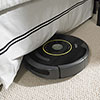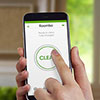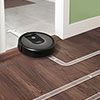As the weather gets warmer, it’s time to start thinking about spring cleaning, and one of the most important elements of this task is vacuuming all those little-used spaces you don’t usually get around to cleaning. Why not have a robot do your vacuuming for you instead? Yes, really.
It might sound like an Internet start-up but the Roomba is actually one of the most well-established and innovative cleaning products on the market. Roomba is a series of autonomous robot vacuums first developed by iRobot in 2002. Let’s take a closer look at what’s beneath the hood of these nifty home cleaning gadgets.
How the Roomba Works
 All Roomba models are disc-shaped and less than four inches tall so they can slide beneath most common household furniture. Features of the robot’s design include a large contact-sensing mechanical bumper, an omnidirectional infrared sensor, and a recessed carrying handle. The Roomba uses a combination of rotating brushes and a squeegee vacuum to pick up debris as well as fine dust. Four contact sensors also prevent the robotic vacuum from falling off ledges. Some of iRobot’s higher-end models use a proprietary technology called vSLAMes to confine a Roomba to a single room until it’s clean, and then proceed to the next space to be cleaned.
All Roomba models are disc-shaped and less than four inches tall so they can slide beneath most common household furniture. Features of the robot’s design include a large contact-sensing mechanical bumper, an omnidirectional infrared sensor, and a recessed carrying handle. The Roomba uses a combination of rotating brushes and a squeegee vacuum to pick up debris as well as fine dust. Four contact sensors also prevent the robotic vacuum from falling off ledges. Some of iRobot’s higher-end models use a proprietary technology called vSLAMes to confine a Roomba to a single room until it’s clean, and then proceed to the next space to be cleaned.
Use the Right Mode for Cleaning
 Each Roomba also has additional operating modes. “Clean” is the default setting, in which the Roomba starts in a spiral pattern and follows walls until the room is clear. The “Spot” setting is used to clean a small space in a spiral pattern. The “Max” setting runs the standard cleaning algorithm until the battery is depleted. A new feature of Roomba is the addition of iROBOT’s new HOME app, which is available for iOS and Android devices.
Each Roomba also has additional operating modes. “Clean” is the default setting, in which the Roomba starts in a spiral pattern and follows walls until the room is clear. The “Spot” setting is used to clean a small space in a spiral pattern. The “Max” setting runs the standard cleaning algorithm until the battery is depleted. A new feature of Roomba is the addition of iROBOT’s new HOME app, which is available for iOS and Android devices.
The cleaning time for each Roomba depends on room size and the volume of dirt or fine dust in the room. Battery life has been a consistent concern from consumers, despite the fact that battery replacements from Roomba cost significantly less than the base price of the unit. Currently, the four available Roomba robot vacuums on the market range in price from $374 for the Roomba 650 to $899 for the advanced Roomba 980, which includes a 120-minute battery life, remote access, and more advanced cleaning technologies.
High Technology at Work
 Despite their highly technical appearance, Roombas do not map out the rooms they are cleaning. Instead, these robots use a proprietary technology called the iAdapt Responsive Cleaning Technology, which employs simple algorithms to attune the vacuum to its environment. iRobot’s Rodney Brooks has stated that he believes the robots should act like insects, using simple surveillance and control mechanisms to adapt to their environment. When the Roomba does rarely but inevitably gets stuck, it uses a synthesized voice to announce the problem and suggest a solution. There’s nothing better than a robot that can ask for help!
Despite their highly technical appearance, Roombas do not map out the rooms they are cleaning. Instead, these robots use a proprietary technology called the iAdapt Responsive Cleaning Technology, which employs simple algorithms to attune the vacuum to its environment. iRobot’s Rodney Brooks has stated that he believes the robots should act like insects, using simple surveillance and control mechanisms to adapt to their environment. When the Roomba does rarely but inevitably gets stuck, it uses a synthesized voice to announce the problem and suggest a solution. There’s nothing better than a robot that can ask for help!
In addition to its popular robot vacuum, iRobot does make several other kinds of robots for particular use, including a mapping robot, a pool-cleaning robot, and a robot designed to clean gutters. Visit iRobot’s Roomba site to learn more about these complex but incredibly useful robot vacuums.
Photos courtesy of iRobot.